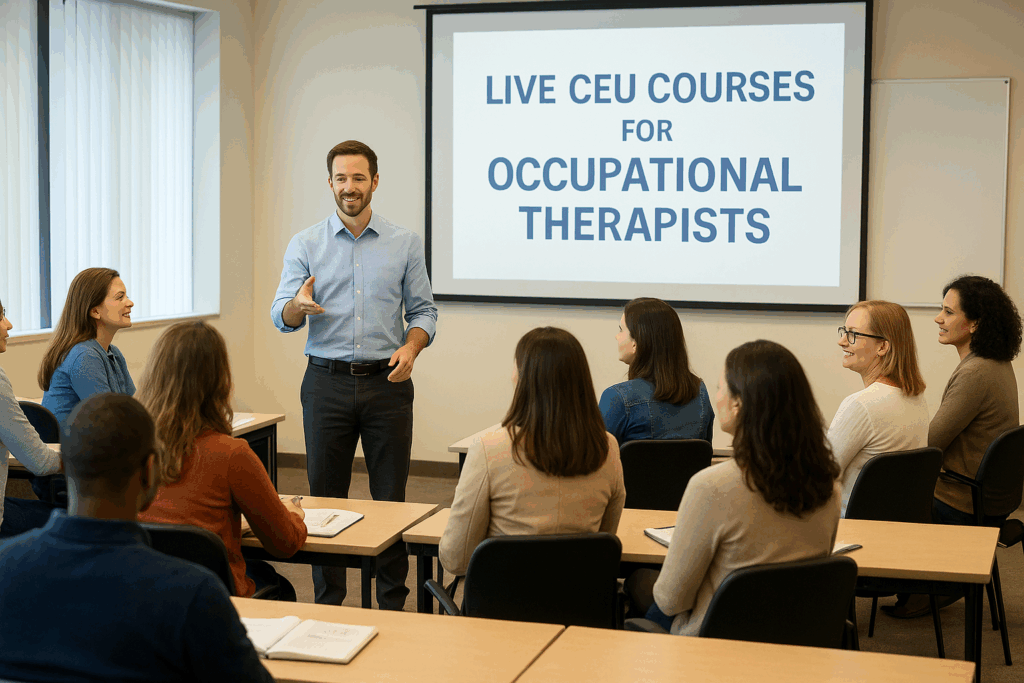Cours de formation continue en direct pour ergothérapeutes : le guide ultime de l'apprentissage et de la croissance
Classé sous Non classé
Introduction to Live CEU Courses
Continuing education is a cornerstone of professional development in healthcare, and for occupational therapists, it’s not just a recommendation—it’s often a requirement. Live CEU courses for occupational therapists provide the perfect balance of structured learning, peer interaction, and hands-on training that self-paced online modules often lack.
Whether you’re a new graduate looking to sharpen your skills or a seasoned professional seeking to stay updated with the latest techniques, live CEU courses can help you expand your knowledge and boost your confidence in clinical practice.

What Are CEU Courses in Occupational Therapy?
CEU stands for Continuing Education Units. These courses ensure that occupational therapists remain up to date with emerging research, treatment techniques, and best practices. Each course earns you credits that can be applied toward state licensure renewal requirements.
Why Occupational Therapists Need Continuing Education
Occupational therapy is constantly evolving with new evidence-based interventions. CEUs allow therapists to:
- Stay compliant with licensure laws.
- Improve patient outcomes with updated practices.
- Explore specialized areas such as pediatrics, geriatrics, or hand therapy.
- Enhance professional credibility and career opportunities.
Benefits of Live CEU Courses for Occupational Therapists
Real-Time Interaction with Instructors
Unlike pre-recorded courses, live CEUs let you ask questions and receive immediate feedback, which deepens your understanding of complex concepts.
Networking Opportunities with Peers
These courses often bring together therapists from different specialties, creating opportunities to exchange insights, share challenges, and even collaborate professionally.
Hands-On Skill Development
For techniques that require practice—like manual therapy, splinting, or sensory integration—live courses provide invaluable hands-on demonstrations.
Comparing Live vs. Online CEU Options
Flexibility and Accessibility
- CEU en ligne: Study anytime, anywhere.
- CEU en direct: Offer structure and accountability.
Cost and Value Differences
While online options may be cheaper, live courses often provide added value in skill mastery and direct mentorship.
Which Option Fits Your Learning Style?
If you thrive on interaction, feedback, and practical demonstrations, live CEUs are the superior choice.
Popular Topics in Live CEU Courses for Occupational Therapists
Hand Therapy and Fine Motor Skills
Specialized training in splinting, upper extremity rehab, and fine motor skill recovery.
Ergothérapie pédiatrique
Learn strategies for working with children who have developmental delays, autism, or sensory processing disorders.
Réadaptation gériatrique
Gain expertise in fall prevention, dementia care, and mobility training.
Neurological and Cognitive Rehabilitation
Stay updated on stroke rehabilitation, traumatic brain injury recovery, and memory interventions.
Comment choisir le bon cours CEU
Accréditation et exigences de l'État
Always verify that the course is recognized by your state licensing board.
Instructor Expertise and Credentials
Look for instructors with real-world clinical experience and strong academic backgrounds.
Course Reviews and Alumni Feedback
Check feedback from past participants to ensure quality and relevance.
Best Platforms Offering Live CEU Courses for Occupational Therapists
- AOTA (Association américaine d'ergothérapie) – The gold standard for OT education.
- HandTherapyAcademy.com – Known for high-quality interactive sessions.
- University & Hospital Programs – Often provide cutting-edge, research-backed training.
Learn more about CEU accreditation at the official AOTA website.
Tips to Maximize Learning in Live CEU Courses
- Prepare Before Attending – Review course materials in advance.
- Take Notes Effectively – Use bullet points and highlight key techniques.
- Apply Knowledge in Daily Practice – Reinforce learning by immediately applying new strategies with patients.
FAQs about Live CEU Courses for Occupational Therapists
Q1. How many CEUs do occupational therapists need per year?
Requirements vary by state, but most require between 12–24 CEU hours annually.
Q2. Are live CEU courses more expensive than online ones?
Yes, generally, but the investment often pays off through skill mastery and networking.
Q3. Can live CEU courses be counted toward license renewal?
Absolutely—provided they’re accredited by a recognized body like AOTA.
Q4. How do I find upcoming live CEU workshops near me?
Check professional associations, university events, and continuing education platforms.
Q5. Do employers reimburse CEU course costs?
Many healthcare organizations do offer reimbursement—always ask your HR department.
Q6. Can I combine live and online CEUs to meet my requirements?
Yes, most boards accept a mix, but check state-specific guidelines.
Conclusion: Advancing Your Career with Live CEU Courses
Live CEU courses for occupational therapists are more than just a requirement—they’re a powerful tool for growth, innovation, and career advancement. They offer opportunities for networking, practical skills, and real-time feedback that online options can’t always match. By investing in live education, you’re not only meeting licensure requirements but also elevating your professional impact.
Plus à lire
Protocole de réparation des tendons extenseurs (zones 4-7) : mouvement actif contrôlé immédiat (ICAM)
Howell, JW, Merritt, WH et Robinson, SJ (2005). Mouvement actif contrôlé immédiat après la réparation du tendon extenseur de la zone 4 à 7. Journal de thérapie de la main : 18, 182-90. The Skinny - Pendant des années, l'immobilisation était la procédure standard suite à des blessures au tendon extenseur dans les zones 4 à 7. Comme prévu, l’immobilisation a entraîné de longs temps de rééducation, des raideurs articulaires et des adhérences tendineuses souvent…
En savoir plus3 raisons courantes de douleur au poignet du côté ulnaire et options de traitement par thérapie non chirurgicale de la main
3 raisons courantes de douleur au poignet du côté ulnaire
En savoir plusDouleur au pilier après une chirurgie de libération du canal carpien
Douleur pilier après une chirurgie de libération du canal carpien La chirurgie de libération du canal carpien (CTR) est une procédure courante, la majorité des patients étant satisfaits de ses résultats. Cependant, chez certaines personnes, une complication temporaire connue sous le nom de « douleur pilier » peut survenir, affectant environ 131 TP3T des personnes subissant une CTR. La douleur pilier se manifeste au niveau de l’éminence thénar et de l’hypothénar…
En savoir plusCréer un plan d'action pour aborder la santé mentale en clinique
Blog Par : Rachel Reed En tant que thérapeutes de la main, nos soins prodigués à nos patients doivent être guidés par l'objectif de traiter la personne dans son ensemble, et pas seulement sa main ou sa blessure (Hannah, 2011). L'ergothérapie est une profession unique dans laquelle nous sommes équipés pour voir nos patients sous un angle holistique. Avec cet objectif, nous sommes…
En savoir plusInscrivez-vous pour recevoir des mises à jour directement dans votre boîte de réception !
Inscrivez-vous avec nous et nous vous enverrons régulièrement des articles de blog sur tout ce qui concerne la thérapie des mains, des notifications chaque fois que nous mettons en ligne de nouvelles vidéos et tutoriels, ainsi que des documents, des protocoles et d'autres informations utiles.






